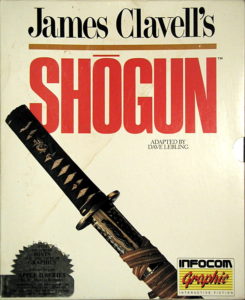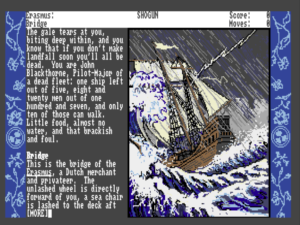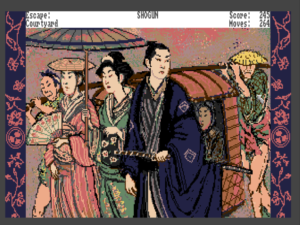One of the generation of male writers forged in the crucible of World War II, James Clavell had a much harder war of it than such peers as Norman Mailer, James Jones, Herman Wouk, Gore Vidal, J.D. Salinger, and James Michener. As a young man of barely twenty years, he found himself facing the Japanese onslaught on the Malay Peninsula at the onset of hostilities in the Pacific Theater. Following the most humiliating British defeat of the entire war, he spent the next three and a half years in prisoner-of-war camps, watching as more than nine out of every ten of his fellow soldiers succumbed to malnutrition, disease, and random acts of violence. Somehow he survived it all and made it home.
In 1953, he emigrated from his native England to Hollywood in the hope of becoming a film director, despite knowing only as much about how movies were made as his actress wife had deigned to tell him. He gradually established himself there as a director and screenwriter by dint of pluck and sheer stubbornness. Clavell claimed he learned how to write stories with mass appeal in Hollywood, developing a style that would preclude more than the merest flirtations with the sort of literary respectability enjoyed by the list of names that opened this article. To hear him tell it, that was just fine with him: “The first time you write a novel you go into ecstasy with the purple prose — how the clouds look, what the sunset is like. All bullshit. What happens? Who does what to whom? That’s all you need.”
If one James Clavell novel was going to please serious students of the literary arts, it would have to be his first, a very personal book in comparison to the epic doorstops for which he would later become known. Holding true to the old adage that everyone’s first novel is autobiographical, King Rat was a lightly fictionalized account of Clavell’s grim experience as a prisoner-of-war. Published in 1962, its success, combined with his difficulty finding sufficient screenwriting gigs, led him to gradually shift his focus from screenplays to novels. The next book he wrote, Tai-Pan (1966), was a much longer, more impersonal, wider-angle historical novel of the early years of Hong Kong. Four similar epics would follow at widely spaced intervals over the next thirty years or so, all chronicling the experiences of Westerners in the Asia of various historical epochs.
James Clavell’s fiction was in many ways no more thoughtful than the majority of the books clogging up the airport bestseller racks then and now. His were novels of adventure, excitement, and titillation, not introspection. Yet there is one aspect of his work that still stands out as surprising, even a little noble. Despite the three and a half years of torture and privation he had endured at the hands of his Japanese captors, he was genuinely fascinated by Asian and especially Japanese culture and history; one might even say he came to love it. And nowhere was that love more evident than in Clavell’s third novel, his most popular of all and the one that most of his fans agree stands as his best: 1975’s Shogun.
The star of Shogun is a typical Clavell hero, a Capable Man whose inner life doesn’t seem to run much deeper than loving queen and country and hating Papists. John Blackthorne is the English pilot — i.e., navigator — of the Erasmus, the first Dutch vessel to discover Japan, circa 1600. Unfortunately, the Spanish and Portuguese are already there when the Erasmus arrives, a situation from which will spring much of the drama of this very lengthy tale of 1100-plus pages. Blackthorne becomes Clavell’s reader surrogate, our window into the strangeness, wonder, mystery, and beauty of feudal Japan.
While Blackthorne’s adventures in Japan are (very) roughly based on those of an actual English adventurer named William Adams, Clavell plays up the violence and the sex for all its worth. Many a youthful reader went to bed at night dreaming fever dreams of inscrutable and lovely geishas and the boxes of toys they kept to hand: “The beads are carefully placed in the back passage and then, at the moment of the Clouds and the Rain, the beads are pulled out slowly, one by one.” Read by adults, such passages… er, extracts are still riotously entertaining in the way that only truly committed Bad Writing can be. My wife Dorte and I used Shogun as our bedtime reading recently. While it didn’t do much to encourage conjugal sexy times, it certainly did make us laugh; Dorte still thinks “pillowing,” Shogun‘s favorite Japanese euphemism for sex, is unaccountably hilarious, and is forever going on about pillowing this and pillowing that. (She also loves the notion of a “poop deck,” but I suppose I can’t blame Clavell for that.)
Unsubtle prose and dodgy euphemisms aside, the first 25 to 30 percent of Shogun is by far the most compelling. Long enough to form a novel of reasonable length in their own right, the early chapters detail the arrival of Blackthorne and his Dutch cohorts in Japan, upon whose shores they literally wash up, starving and demoralized after their long voyage across the Pacific. I’ve occasionally heard the beginning of Shogun described as one of the finest stories of first contact between two alien cultures ever written, worthy of careful study by any science-fiction author who proposes to tell of a meeting between even more far-flung cultures than those of Europe and Japan. To that suggestion I can only heartily concur. As Blackthorne and his cohorts pass from honored guests to condemned prisoners and back again, struggling all the while to figure out what these people want from them, what they want from each other, and how to communicate at all, the story is compulsively readable, the tension at times nearly unbearable. (One suspects that some of the most horrific scenes, like the ones after Blackthorne and the crew are cast into a tiny hole and left to languish there in sweltering heat and their own bodily filth, once again draw from Clavell’s own prisoner-of-war experiences.) While I admit to being far from intimately familiar with the whole of the James Clavell oeuvre, I’d be very surprised if he ever wrote anything better than this.
After Blackthorne, stalwart Capable Man that he is, manages to negotiate a reprieve for the crew and a place for himself as a trusted advisor to a powerful daimyo named Toranaga, the book takes on a different, to my mind less satisfying character. It ceases to focus so much on Blackthorne’s personal plight as a stranger in a strange land in favor of a struggle for control of the entire country, once again based loosely on actual history, that is taking place between Toranaga, very broadly speaking the good guy (or at least the one with whom our hero Blackthorne allies himself), and another daimyo named Ishido. At the same time, the Portuguese Jesuits are trying to stake out a space in the middle that will preserve their influence regardless of who wins, whilst also working righteously to find some way to do away with Blackthorne and the Dutch sailors, who if allowed to return to Europe with information on exactly where Japan lies represent an existential threat to everything they’ve built there. Plot piles on counter-plot on conspiracy on counter-conspiracy, interspersed with regular action-movie set-pieces, as all of the various factions maneuver toward the inevitable civil war that will decide the fate of all Japan for decades or centuries to come.
In the meantime, Blackthorne, apparently deciding his life isn’t already dangerous enough, is carrying on an illicit romance with the beautiful Mariko, wife of one of Toranaga’s most highly placed samurai. Their relationship was much discussed in Shogun‘s first bloom of popularity as being the key to the book’s considerable attraction for female readers; very unusually for such a two-fisted tale of war, adventure, and history, Shogun supposedly enjoyed more female readers than male. True to Clavell’s roots, however, Blackthorne and Mariko’s is a depressingly conventional Hollywood romance. We’re expected to believe that these two characters are wildly, passionately in love with one another simply because Clavell tells us they are, according to the Hollywood logic that two attractive people of the opposite sex thrown into proximity with one another must automatically fall in love — and of course lots of sex must follow.
The plot continues to grow ever more byzantine as the remaining page-count dwindles, and one goes from wondering how Clavell is ever going to wrap all this up to checking Amazon to be sure there isn’t a direct sequel. And then it all just… stops, leaving more loose threads dangling than my most raggedy tee-shirt. I’ve read many books with unsatisfying endings, but I don’t know if I’ve ever read an ending as half-baked as this one. It’s all finally come down to the war that’s been looming throughout the previous 1100-plus pages. We’re all ready for the bloody climax. Instead Clavell gives us a three-page summary of what might have happened next if he’d actually bothered to write it. It’s for all the world like Clavell, who admitted that he wrote his novels with no plan whatsoever, simply got tired of this one, decided 1100 pages was more than enough and just stopped in medias res. Shogun manages the feat, perhaps unique in the annals of anticlimax, of feeling massively bloated and half-finished at the same time. This is a Lord of the Rings that ends just as Frodo and Sam arrive in Mordor; a Tale of Two Cities that ends just as Carton is about to make his final sacrifice. I’ve never felt so duped by a book as this one.
But I must admit that I seem to be the exception here. Whether because of the masterfully taut beginning of the story, the torrid love affair, or the lurid portrayal of Japanese culture that pokes always through the tangled edifice of plot, few readers then or now seem to share my reservations. Shogun became an instant bestseller. In 1980, a television miniseries of the book was aired in five parts, filling more than nine hours sans commercials. It became the most-watched show ever aired on NBC and the second most popular in the history of American television, its numbers exceeded only by those of Roots, another miniseries event which had aired on ABC in 1977. When many people think of Blackthorne today, they still picture Richard Chamberlain, the dashing actor who played him on television. Together the book and the miniseries ignited a craze for Japanese culture in the West that, however distorted or exaggerated it may have been, did serve as a useful counterbalance to lingering resentments over World War II and, increasingly, fears that Japan’s exploding technological and industrial base was about to usurp the United States’s place at the head of the world’s economy.
At this point, at last, Shogun‘s huge popularity on page and screen brings us in our roundabout way to Infocom — or, more accurately, to their corporate masters Mediagenic. [1]Mediagenic was known as Activision until mid-1988. To avoid confusion, I just stick with the name “Mediagenic” in this article. (If the preface to the real point of this article seemed crazily extended, I can only plead that, with Shogun the game having little identity of its own apart from the novel on which it’s based, it’s hard to discuss it through any other framework.)
Mediagenic’s absolute mania for licensed games following the accession of Bruce Davis to the CEO’s chair has been well-established in other articles by now. Infocom was able to find some excuse to head off most of the ideas in that vein that Mediagenic proposed, but Shogun was an exception. When Mediagenic came to Infocom with a signed deal already in place in late 1987 to base a game on this literary property — from Bruce Davis’s perspective, the idea was right in Infocom’s wheelhouse — their problem child of a subsidiary just wasn’t in any position to say no. Dave Lebling, having recently finished The Lurking Horror and being without an active project, drew the short straw.
Shogun the game was a misbegotten, unloved project from the start, a project for which absolutely no one in the Infocom, Mediagenic, or Clavell camps had the slightest creative passion. The deal had been done entirely by Clavell’s agent; the author seemed barely aware of the project’s existence, and seemed to care about it still less. It was a weird choice even in the terms of dollars and cents upon which Bruce Davis was always so fixated. Yes, Shogun had been massively popular on page and screen years earlier, and still generated strong catalog sales every year. It was hard to imagine, however, that there was a huge crowd of computer gamers dying to relive the adventures of John Blackthorne interactively. Why this of all licenses? Why now?
Dave Lebling was duly dispatched to visit Clavell for a few days at his chalet in the Swiss Alps to discuss ideas for the adaptation; he got barely more than a few words of greeting out of the man. His written requests for guidance were answered with the blunt reply that Clavell had written the book more than a decade ago and didn’t remember that much about it; the subtext was that he couldn’t be bothered with any of it, that to him Lebling’s game represented just another check arranged by his agent. Lebling was left entirely on his own to adapt another author’s work, with no idea of where the boundaries to his own creative empowerment might lie. In the past, Infocom had always taken care to avoid just this sort of collaboration-in-name-only. Now they’d had it imposed upon them.
Lebling chose to structure his version of Shogun as a series of Reader’s Digest “scenes from” the novel, cutting and pasting unwieldy chunks of Clavell’s prose into the game and demanding that the player respond by doing exactly what Blackthorne did in the novel in order to advance to the next canned scene. The player who has read the novel will find little interest or challenge in pantomiming her way through a re-creation of same, while the player who hasn’t will have no idea whatsoever what’s expected of her at any given juncture. It’s peculiar to see such a threadbare design from a company as serious about the craft of interactive fiction as Infocom had always been. Everyone there, not least Lebling himself, understood all too well the problems inherent in this approach to adaptation; these very same problems were the main reason Infocom had so steadfastly avoided literary licenses that didn’t come with their authors attached in earlier years. One can only presume that Lebling, unsure of how far his creative license extended and bored to death with the whole project anyway, either couldn’t come up with anything better or just couldn’t be bothered to try.
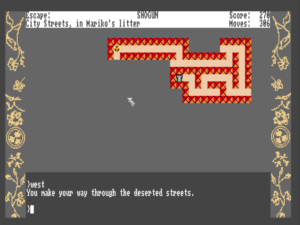
Shogun includes one graphical puzzle reminiscent of those in Zork Zero, a maze representing the tangled alleys of Osaka.
Consider the game’s handling of an early scene from the novel: the first time Blackthorne meets Yabu and Omi, respectively the daimyo and his samurai henchman who have dominion over Anjiro, the small fishing village where the Erasmus has washed up. Also present as translator is a Portuguese priest, Blackthorne’s sworn enemy, who would like nothing better than to see him condemned and executed on the spot. In the book, Blackthorne’s observations of the priest’s interactions with the two samurai convince him that there is no love lost between him and them, that Yabu and Omi hate and mistrust the priest almost as much as Blackthorne does. Blackthorne wants to communicate that he shares their sentiment, but of course all of his words are being translated into Japanese by the priest himself — obviously a highly unreliable means of communication in this situation. Desperate to show his captors that he’s different from this other foreigner, he lunges at the priest, grabs his crucifix, and breaks it in two, a deadly sin for a Catholic but a good day’s work for a Protestant like him. Yabu and especially Omi are left curious and more than a little impressed; Blackthorne’s action quite possibly staves off his imminent execution.
In the book, this all hangs together well enough, based on what we know and what we soon learn of the personalities, histories, and cultures involved. But for the game to expect the player to come up with such a seemingly random action as lunging for the crucifix and breaking it is asking an awful lot of anyone unfamiliar with the novel. It’s not impossible to imagine the uninitiated player eventually coming up with it on her own, especially as Lebling is good enough to drop some subtle hints about the crucifix “on its long chain waving mockingly before your face,” but she’ll likely do so only by dying and restoring many times.
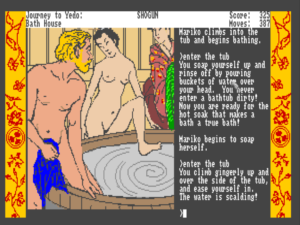
Shogun is the only Infocom game outside of Leather Goddesses of Phobos in which you have to “make love to” someone — or type another euphemism, if you like — in order to score points. (Unfortunately, you can’t use “pillow” as a verb. This Dorte finds deeply disappointing.) It’s also, needless to say, the only one with nudity. Too bad Blackthorne is covering up his manly member, whose size is a constant point of discussion in the book.
And this is far from the worst of Lebling’s “read James Clavell’s mind” moments. In their announcement of the game in their newsletter, Infocom noted that “the key to success in the interactive Shogun is the ability to act as the British pilot-major Blackthorne would.” For the player who hasn’t read the book and thus doesn’t know Blackthorne, this is quite a confusing proposition. For the player who has, the game falls into a rote pattern. Remember (or look up) what Blackthorne did in the book, figure out how and when to phrase it to the parser, and you get some points and get to live a little longer. Do anything else, and you die or get a message saying “this scene is no longer winnable” and get to try again. In between, you do a lot of waiting and examining, and lots of reading of textual cut scenes — called “interludes” by the game — that grow steadily lengthier as the story progresses and Blackthorne’s part in it becomes more and more ancillary.
In a telling indication of how the times had changed for Infocom, by far the most impressive aspect of Shogun is its visual presentation. Promoted, like the earlier Zork Zero, as “graphical interactive fiction,” it and the simultaneously released Journey are the first Infocom games to unabashedly indulge in pictures for their own sake, abandoning Steve Meretzky’s insistence that his game’s graphics always serve a practical gameplay function. Shogun‘s pictures, drawn in the style of classical Japanese woodcuts by Donald Langosy, are lovely to look at and perfectly suit the atmosphere of the novel. The game’s one truly innovative aspect is the same pictures’ presentation onscreen. Rather than being displayed in a static window, they’re scattered around and within the scrolling text in various positions, giving the game the look of an unfurling illustrated scroll. Infocom had had their share of trouble figuring out the graphics thing, but Shogun demonstrates that, clever bunch that they were, they were learning quickly. Already Infocom’s visual palette was far more sophisticated than that of competitors like Magnetic Scrolls and Level 9 who had been doing text adventures with pictures for years. Pity they wouldn’t have much more time to experiment.
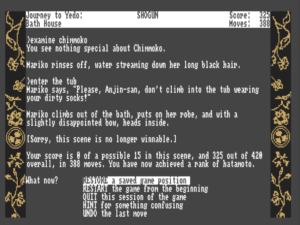
“The socks stay on, Mariko!” [2]Al and Peg
But of course, as Infocom’s vintage advertisements loved to tell us, visuals alone do not a great game make. Shogun stands today as the most unloved and unlovable of all Infocom’s games, a soulless exercise in pure commerce that didn’t make a whole lot of sense even on that basis. Released in March of 1989, its sales were, like those of all of this final run of graphical games, minuscule. In my opinion and, I would venture, that of a substantial number of others, it represents the absolute nadir of Infocom’s 35-game catalog. It is, needless to say, the merest footnote to the bestselling catalog of James Clavell, who died in 1994. And, indeed, it’s little more worthy of discussion in the context of Infocom’s history; the words I’ve devoted to it already are far more than it deserves. I have two more Infocom games to discuss in future articles, each with problems of their own, but we can take consolation in one thing: it will never, ever get as bad as this again. This, my friends, is what the bottom of the barrel looks like.
(Sources: As usual with my Infocom articles, much of this one is drawn from the full Get Lamp interview archives which Jason Scott so kindly shared with me. Some of it is also drawn from Jason’s “Infocom Cabinet” of vintage documents. And the very last issue of Infocom’s The Status Line newsletter, from Spring 1989.)
Footnotes
| ↑1 | Mediagenic was known as Activision until mid-1988. To avoid confusion, I just stick with the name “Mediagenic” in this article. |
|---|---|
| ↑2 | Al and Peg |
